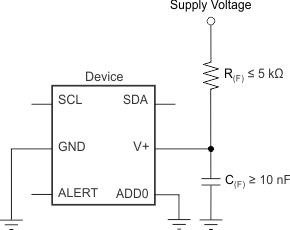JAJS306H August 2007 – December 2018 TMP102
PRODUCTION DATA.
- 1 特長
- 2 アプリケーション
- 3 概要
- 4 改訂履歴
- 5 Pin Configuration and Functions
- 6 Specifications
-
7 Detailed Description
- 7.1 Overview
- 7.2 Functional Block Diagram
- 7.3 Feature Description
- 7.4 Device Functional Modes
- 7.5
Programming
- 7.5.1 Pointer Register
- 7.5.2 Temperature Register
- 7.5.3
Configuration Register
- Table 10. Byte 1 of Configuration and Power-Up or Reset Format
- Table 11. Byte 2 of Configuration and Power-Up or Reset Format
- 7.5.3.1 Shutdown Mode (SD)
- 7.5.3.2 Thermostat Mode (TM)
- 7.5.3.3 Polarity (POL)
- 7.5.3.4 Fault Queue (F1/F0)
- 7.5.3.5 Converter Resolution (R1/R0)
- 7.5.3.6 One-Shot (OS)
- 7.5.3.7 EM Bit
- 7.5.3.8 Alert (AL Bit)
- 7.5.3.9 Conversion Rate (CR)
- 7.5.4 High- and Low-Limit Registers
- 8 Application and Implementation
- 9 Power Supply Recommendations
- 10Layout
- 11デバイスおよびドキュメントのサポート
- 12メカニカル、パッケージ、および注文情報
8.2.2 Detailed Design Procedure
Place the TMP102 device in close proximity to the heat source that must be monitored, with a proper layout for good thermal coupling. This placement ensures that temperature changes are captured within the shortest possible time interval. To maintain accuracy in applications that require air or surface temperature measurement, care must be taken to isolate the package and leads from ambient air temperature. A thermally-conductive adhesive is helpful in achieving accurate surface temperature measurement.
The TMP102 device is a very low-power device and generates very low noise on the supply bus. Applying an RC filter to the V+ pin of the TMP102 device can further reduce any noise that the TMP102 device might propagate to other components. R(F) in Figure 15 must be less than 5 kΩ and C(F) must be greater than 10 nF.
 Figure 15. Noise Reduction Techniques
Figure 15. Noise Reduction Techniques